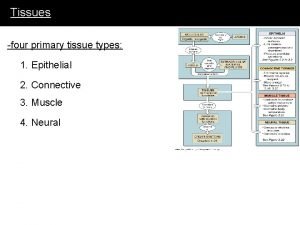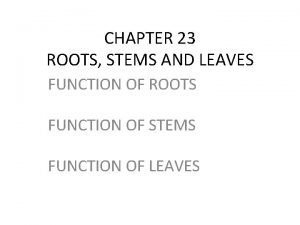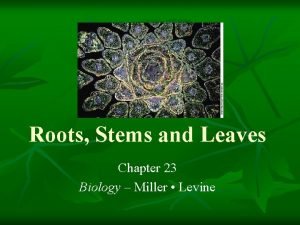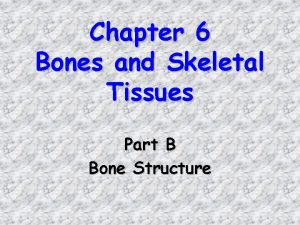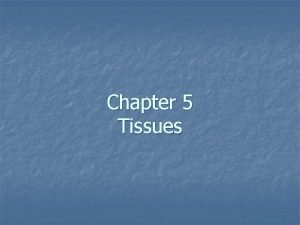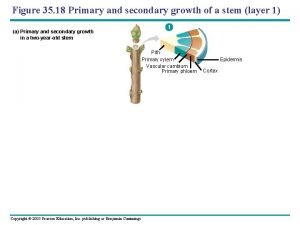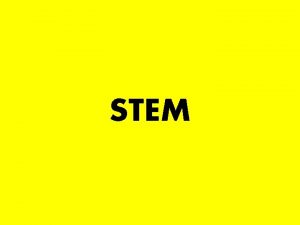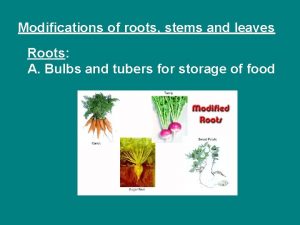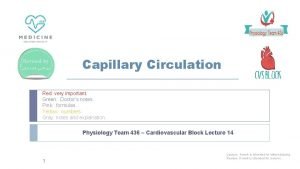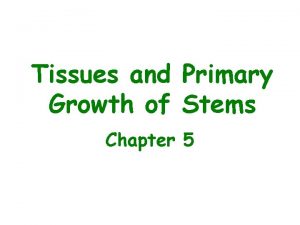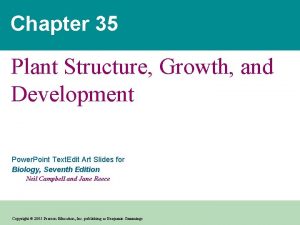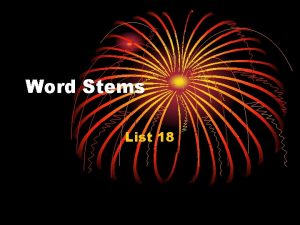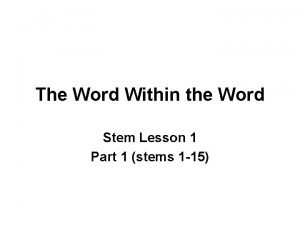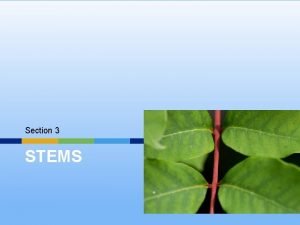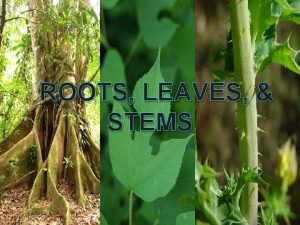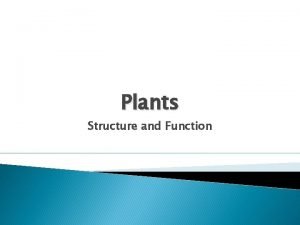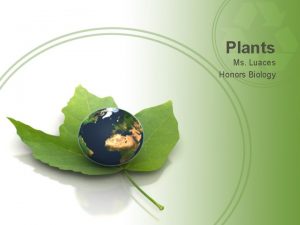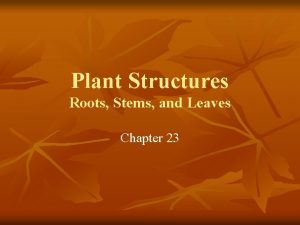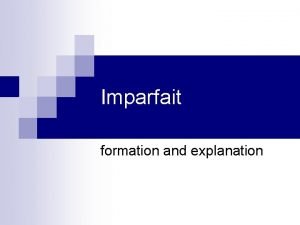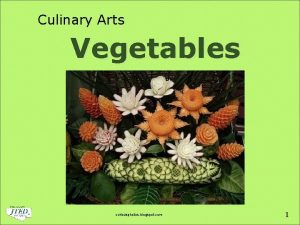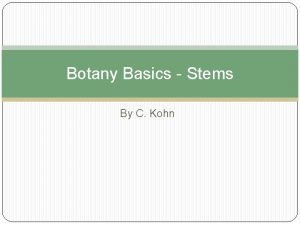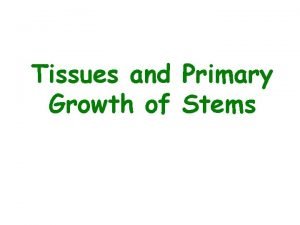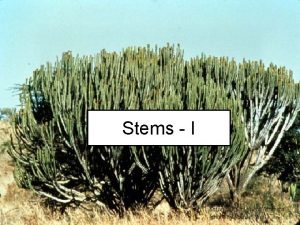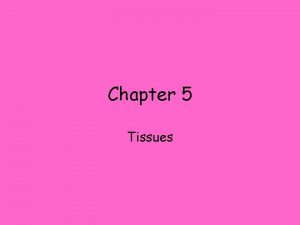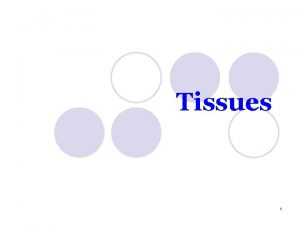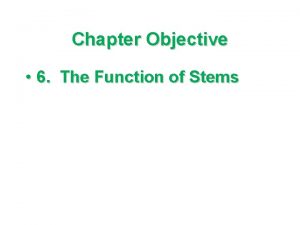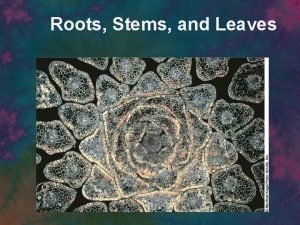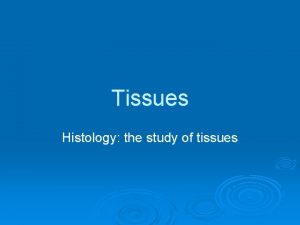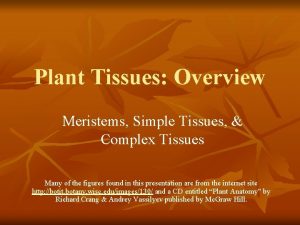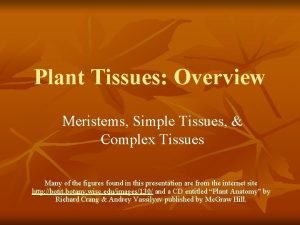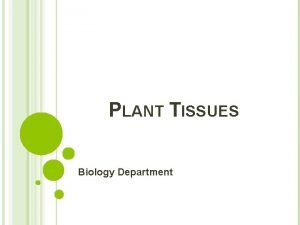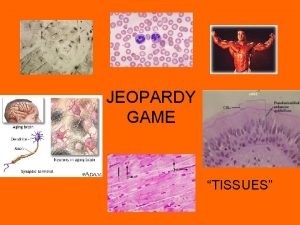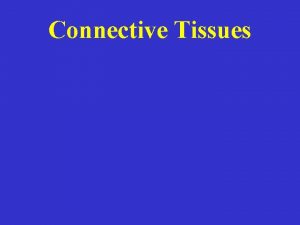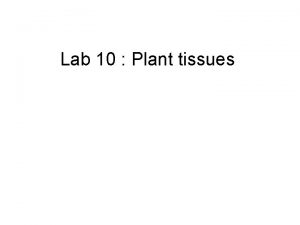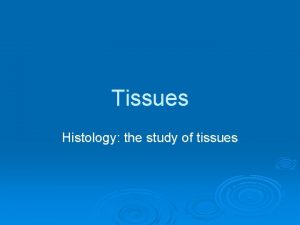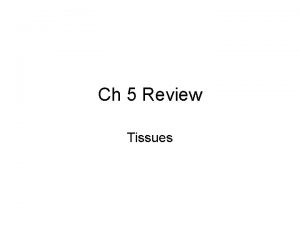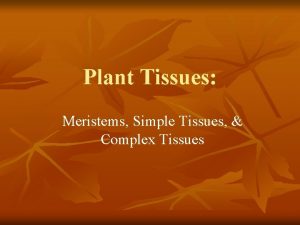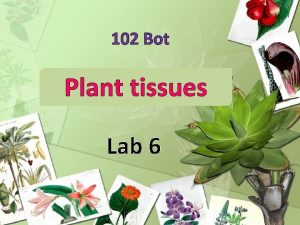Tissues and Primary Growth of Stems Chapter 5











































- Slides: 43

Tissues and Primary Growth of Stems Chapter 5

The Plant Body: Stems FUNCTION OF STEMS • Stems support leaves and branches. • Stems transport water and solutes between roots and leaves. • Stems in some plants are photosynthetic. • Stems may store materials necessary for life (e. g. , water, starch, sugar). • In some plants, stems have become adapted for specialized functions. Used with permission from http: //education-portal. com

– May be vegetative (leaf bearing) or reproductive (flower bearing). – Node- area of stem where leaf is born – Internodes- stem area between nodes – Buds: Stem elongation. Embryonic tissue of leaves and stem (not flower bud) – Terminal bud- Located at tip of stems or branches. – Axillary bud- Gives rise to branches – Apical Dominance: Prevention of branch formation by terminal bud

The stem

Parts of the Stem – Xylem • Water and minerals travel up to other plant parts – Phloem • Manufactured food travels down to other plant parts – Cambium – Separates xylem and phloem

Plant Tissues 1) Dermal Tissue System • Outer covering • Protection 2) Vascular Tissue System • “Vessels” throughout plant • Transport materials 3) Ground Tissue System • “Body” of plant • Photosynthesis; storage; support Used with permission from http: //education-portal. com

Stems – Structure and Development • Stems have all three types of plant tissue • Grow by division at meristems – Develop into leaves, other shoots, and even flowers • Leaves may be arranged in one of three ways

Stems – Many Plants Have Modified Stems Rhizomes Bulbs Storage leaves Stem Stolons Stolon Tubers

• Modified shoots with diverse functions have evolved in many plants. – These shoots, which include stolons, rhizomes, tubers, and bulbs, are often mistaken for roots. – Stolons, such as the “runners” of strawberry plants, grow on the surface and enable a plant to colonize large areas asexually when a parent plant fragments into many smaller offspring. Fig. 35. 4 a Copyright © 2002 Pearson Education, Inc. , publishing as Benjamin Cummings

– Rhizomes, like those of ginger, are horizontal stems that grow underground. – Tubers, including potatoes, are the swollen ends of rhizomes specialized for food storage. – Bulbs, such as onions, are vertical, underground shoots consisting mostly of the swollen bases of leaves that store food. Fig. 35. 5 b-d Copyright © 2002 Pearson Education, Inc. , publishing as Benjamin Cummings

Plant Tissues – Ground Tissue • Some major types of plant cells: – Parenchyma – Collenchyma – Sclerenchyma • Tissues that are neither dermal nor vascular are ground tissue • Ground tissue internal to the vascular tissue is pith; ground tissue external to the vascular tissue is cortex • Ground tissue includes cells specialized for storage, photosynthesis, and support

Parenchyma • Characteristics – least specialized cell type – only thin primary cell wall is present – possess large central vacuole – generally alive at functional maturity • Functions – make up most of the ground tissues of the plant – storage – photosynthesis – can help repair and replace damaged organs by proliferation and specialization into other cells

Collenchyma • Characteristics – possess thicker primary cell walls the that of parenchyma – no secondary cell wall present – generally alive at functional maturity • Functions – provide support without restraining growth

Sclerenchyma • Characteristics – have secondary cell walls strengthened by lignin – often are dead at functional maturity – two forms: fibers and sclereids • Functions – rigid cells providing support and strength to tissues

Sclerenchyma – Fibers are long, slender and tapered, and usually occur in groups. • Those from hemp fibers are used for making rope and those from flax for weaving into linen. – Sclereids, shorter than fibers and irregular in shape • impart the hardness to nutshells and seed coats and the gritty texture to pear fruits.

Vascular Tissue Vascular tissue: Runs continuous throughout the plant • transports materials between roots and shoots. – Xylem transports water and dissolved minerals upward from roots into the shoots. (water the xylem) – Phloem transports food from the leaves to the roots and to non-photosynthetic parts of the shoot system. (feed the phloem)

Overview of Plant Structure • Xylem: – Main water-conducting tissue of vascular plants. – arise from individual cylindrical cells oriented end to end. – At maturity the end walls of these cells dissolve away and the cytoplasmic contents die. – The result is the xylem vessel, a continuous nonliving duct. – carry water and some dissolved solutes, such as inorganic ions, up the plant

Overview of Plant Structure • Phloem: – The main components of phloem are • sieve elements • companion cells. – Sieve elements have no nucleus and only a sparse collection of other organelles. Companion cell provides energy – so-named because end walls are perforated - allows cytoplasmic connections between vertically-stacked cells. – conducts sugars and amino acids - from the leaves, to the rest of the plant

Phloem transport requires specialized, living cells • Sieve tubes elements join to form continuous tube • Pores in sieve plate between sieve tube elements are open channels for transport • Each sieve tube element is associated with one or more companion cells. – Many plasmodesmata penetrate walls between sieve tube elements and companion cells – Close relationship, have a ready exchange of solutes between the two cells

Phloem transport requires specialized, living cells • Companion cells: – Role in transport of photosynthesis products from producing cells in mature leaves to sieve plates of the small vein of the leaf – Synthesis of the various proteins used in the phloem – Contain many, many mitochondria for cellular respiration to provide the cellular energy required for active transport – There ate three types • Ordinary companion cells • Transfer cells • Intermediary cells

Plant Classification – Monocots vs. Dicots Basic categories of plants based on structure and function Copyright © 2002 Pearson Education, Inc. , publishing as Benjamin Cummings

Plant Classification – Monocots vs. Dicots 1 cotyledon 3 floral parts Parallel veins 2 cotyledons 4 or 5 floral parts Netlike veins 1 pore in pollen 3 pores in pollen Stem vascular bundles dispersed Stem vascular bundles in ring

Remember Plant Tissues? 1) Dermal Tissue System • Outer covering • Protection 2) Vascular Tissue System • “Vessels” throughout plant • Transport materials 3) Ground Tissue System • “Body” of plant • Photosynthesis; storage; support Used with permission from http: //education-portal. com

Vasculature - Comparisons • In most monocot stems, the vascular bundles are scattered throughout the ground tissue, rather than forming a ring as with Dicots Phloem Xylem Sclerenchyma (fiber cells) Ground tissue connecting pith to cortex Pith Epidermis Key to labels Epidermis Cortex Vascular bundle Dermal Ground 1 mm (a) Cross section of stem with vascular bundles forming a ring (typical of dicots) Vascular bundles Vascular 1 mm (b) Cross section of stem with scattered vascular bundles (typical of monocots) Copyright © 2002 Pearson Education, Inc. , publishing as Benjamin Cummings

Dicot Stem Anatomy epidermis phloem cortex vascular bundle pith vascular cambium xylem Copyright © 2002 Pearson Education, Inc. , publishing as Benjamin Cummings

Monocot Stem Anatomy phloem epidermis vascular bundles ground tissue Copyright © 2002 Pearson Education, Inc. , publishing as Benjamin Cummings xylem

Plant stem growth § Vegetative development is based on meristems, in which cell division occurs throughout life, producing cells that go on to differentiate. § When a meristem is converted from vegetative to reproductive development, regulatory transcription factors are activated that control the identity and position of floral organs.

Plant Growth 1) Primary Growth: • Apical Meristems: Mitotic cells at “tips” of roots / stems length 1) Increased length 2) Specialized structures (e. g. fruits) girth 2) Secondary Growth: • Lateral Meristems: Mitotic cells “hips” of plant Responsible for increases in stem/root diameter

Plant Growth 1) Indeterminate: Grow throughout life 2) Growth at “tips” (length) and at “hips” (girth) Growth patterns in plant: 1) Meristem Cells: Dividing Cells 2) Differentiated Cells: Cells specialized in structure & role • Form stable, permanent part of plant

Plant Growth Shoot apical meristem Leaf primordia Young leaf Developing vascular strand Axillary bud meristems Copyright © 2002 Pearson Education, Inc. , publishing as Benjamin Cummings

Meristems • The tissue in most plants consisting of undifferentiated cells (meristematic cells), found in zones of the plant where growth can take place. • Meristematic cells are analogous in function to stem cells in animals, are incompletely or not differentiated, and are capable of continued cellular division. • Furthermore, the cells are small and protoplasm fills the cell completely. • • The vacuoles are extremely small. The cytoplasm does not contain chloroplasts although they are present in rudimentary form (proplastids). • Meristematic cells are packed closely together without intercellular cavities. Tunica-Corpus model of the apical meristem (growing tip). The epidermal (L 1) and subepidermal (L 2) layers form the outer layers called the tunica. The inner L 3 layer is called the corpus. Cells in the L 1 and L 2 layers divide in a sideways fashion which keeps these layers distinct, while the L 3 layer divides in a more random fashion.

Plant Growth Two lateral meristems: vascular cambium and cork cambium Primary growth in stems Epidermis Cortex Shoot tip (shoot apical meristem and young leaves) Primary phloem Primary xylem Pith Lateral meristems: Axillary bud meristem Vascular cambium Cork cambium Secondary growth in stems Periderm Cork cambium Cortex Root apical meristems Primary phloem Pith Primary xylem Secondary phloem Vascular cambium Copyright © 2002 Pearson Education, Inc. , publishing as Benjamin Cummings

Plant Growth Stem – Secondary Growth: • thicker, stronger stems Vascular Cambium: between primary xylem and phloem primary phloem vascular cambium primary xylem epidermis Produces inside stem: A) Secondary xylem - moves H 2 O, inward B) Secondary phloem - moves sugars, outward pith cortex primary xylem dividing vascular cambium primary phloem

Vascular cambium • Is a lateral meristem in the vascular tissue of plants. • It is a cylinder of unspecialized meristematic cells that divide to give rise to cells that further divide, differentiate and specialize to form the secondary vascular tissues. • The vascular cambium is the source of both the secondary xylem (inwards, towards the pith) • And the secondary phloem – (outwards), • And is located between these tissues in the stem and root.

Vascular cambium • Made from, procambium that remains undifferentiated between the primary xylem and primary phloem. • Upon maturity, this region is known as the fascicular cambium, and the area of cells between the vascular bundles (fascicles) called pith rays becomes what is called the interfascicular cambium. • The fascicular and inter-fascicular cambiums, therefore, represent a continuous ring which bisects the primary xylem and primary phloem. • The vascular cambium then produces secondary xylem on the inside of the ring, and secondary phloem on the outside, pushing the primary xylem and phloem apart.

Vascular cambium • The vascular cambium usually consists of two types of cells: – – Fusiform initials (tall cells, axially orientated. Ray initials (almost isodiametric cells - smaller and round to angular in shape). • Remember: • The vascular cambium is a type of meristem - tissue consisting of embryonic (incompletely differentiated) cells from which other (more differentiated) plant tissues originate. • Primary meristems are the apical meristems on root tips and shoot tips.

Vascular Cambium: Plant Growth Secondary growth secondary phloem primary xylem secondary xylem primary xylem new secondary xylem dividing vascular cambium new secondary phloem vascular cambium primary phloem pith cortex Vascular cambium Growth X X C P P C C X X C P C C C Secondary xylem Secondary phloem X C P X C C C Vascular cambium After one year of growth Copyright © 2002 Pearson Education, Inc. , publishing as Benjamin Cummings After two years of growth

Production of Secondary Xylem and Phloem – The accumulation of this tissue over the years accounts for most of the increase in diameter of a woody plant. – Secondary xylem forms to the interior and secondary phloem to the exterior of the vascular cambium. C=cambium cell X=2 o xylem P=2 o phloem D=derivative

• • Cork cambium Another lateral meristem is the cork cambium, which produces cork, part of the bark. Together, the secondary vascular tissues (produced by the vascular cambium) and periderm (formed by the cork cambium) makes up the secondary plant body. • Vascular cambia are found in dicots and gymnosperms but not monocots, which usually lack secondary growth. • In wood, the vascular cambium is the obvious line separating the bark and wood. • Capon, Brian (2005). Botany for Gardeners (2 nd ed. ). Portland, OR: Timber Publishing Growth ring Vascular ray Heartwood Secondary xylem Sapwood Vascular cambium Secondary phloem Bark Layers of periderm

• Cork Cambium The cork cambium is a lateral meristem and is responsible for secondary growth that replaces the epidermis in roots and stems. • It is found in woody and many herbaceous dicots, gymnosperms an d some monocots, which usually lack secondary growth. • Growth and development of cork cambium is very variable between different species, and is also highly dependent on age, growth conditions, etc. as can be observed from the different surfaces of bark: – smooth, fissured, tesselated, scaly, flaking off, etc.

Plant Growth Stem – Secondary Growth: heartwood (xylem) sapwood (xylem) vascular cambium phloem annual ring late xylem early xylem Sapwood = Young xylem, water Heartwood = Old xylem, support Seasonal Growth = annual rings Secondary phloem = grows outward older phloem crushed Copyright © 2002 Pearson Education, Inc. , publishing as Benjamin Cummings

Secondary Growth of a Stem Copyright © 2002 Pearson Education, Inc. , publishing as Benjamin Cummings

ANY QUESTIONS?
 Body tissue
Body tissue Body tissue
Body tissue Body tissues chapter 3 cells and tissues
Body tissues chapter 3 cells and tissues Stained cheek cell
Stained cheek cell Eisonophil
Eisonophil Pith
Pith Primary growth and secondary growth in plants
Primary growth and secondary growth in plants Primary growth and secondary growth in plants
Primary growth and secondary growth in plants Cutaneous membrane
Cutaneous membrane Phloem
Phloem Functions of leaf
Functions of leaf Chapter 6 bones and skeletal tissues
Chapter 6 bones and skeletal tissues Which part of the cell contains genetic material
Which part of the cell contains genetic material Cell membrane phospholipids
Cell membrane phospholipids Smooth endoplasmic
Smooth endoplasmic Plant growth definition
Plant growth definition Chapter 5 tissues
Chapter 5 tissues Visualizing primary and secondary growth
Visualizing primary and secondary growth Step growth polymerization vs chain growth
Step growth polymerization vs chain growth Geometric growth population
Geometric growth population Neoclassical growth theory vs. endogenous growth theory
Neoclassical growth theory vs. endogenous growth theory Organic vs inorganic growth
Organic vs inorganic growth Stemtypes
Stemtypes Modified roots
Modified roots Capillary
Capillary Fetal positions
Fetal positions Types of plant tissue
Types of plant tissue Primary growth
Primary growth Stems list 1
Stems list 1 Lesson 1
Lesson 1 Stolon example
Stolon example Functions of the stem
Functions of the stem The folded leaf sat
The folded leaf sat What is the function of stems?
What is the function of stems? Functions of stem
Functions of stem What is the function of stems?
What is the function of stems? What is the function of stems?
What is the function of stems? Incomplete flower
Incomplete flower Imparfait formation
Imparfait formation Higher order thinking iteach flashcards
Higher order thinking iteach flashcards Objectives of vegetables
Objectives of vegetables Power stems from internalized values in p which dictate
Power stems from internalized values in p which dictate Closing sentence stems
Closing sentence stems Above ground stems
Above ground stems








